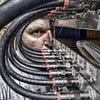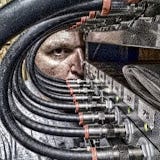Don't Get Left in the DustDon't Get Left in the Dust
Dust will cause your equipment to overheat, cause fans to run more often and louder, air conditioners will work harder, and your equipment will consume more power.
September 6, 2019
I have many clients that see the value in proactive application baselining as well as routing and firewall rule audits but admit they just don’t have the cycles to do it. I am a huge proponent of proactive network management, equipment configuration, and application baselining.
After some past articles on routing audits, I had a lot of positive feedback from readers thanking me for providing a great idea along with others asking me for short cuts and how to automate the process. This is an example of one of the many things I believe people should be doing at work along with any other maintenance items they might have scheduled.
In this article, I will cover a 'Silent Killer' that you probably have in your environment: dust. In a demented way, you'll be one of the lucky ones if dust causes equipment failure because you will know it was an issue and replace the equipment.
For those of you who are less lucky, dust will cause your equipment to overheat, cause fans to run more often and louder, air conditioners will work harder, and more power consumption in general. In most cases, these symptoms will seem to be random until the equipment fails. This is why I call this scenario less lucky.You will spend a lot of time trying to fix the problem and when the equipment recovers, you will claim victory only to have it resurface later.
If you Google “can dust cause equipment failure," you will find over 26 million results, some helpful and others, not so much.The problem is that the combination of environment and equipment makes every scenario unique.You will find many articles claiming dust can't harm equipment to those that claim dust is the worst thing for your equipment.
Since the early 1990s, I have always tried to keep dust out of equipment and strongly believe it has extended the life of my client’s equipment.
This issue is even more important when you are renovating, building, or anything that will cause the level of dust to increase. Even if you don't see dust, trust me, it is there. A great test would be to drag your finger from under the side of your equipment, and you will probably find a baby powder-like dust present.
I understand you can’t rip out your core switch and drag it outside, but you can use a can of compressed air and a vacuum on the other end to collect some of the dust. At least you will be able to see how much dust you’re dealing with.
If you start looking around, you will find vendors that sell filters, enclosures, and other items to reduce the amount of dust that gets into your equipment.Keep in mind that along with some of these solutions come more work to ensure that the filters are cleaned, replaced, etc.
A few years ago, I installed over 120 switches during a new build. After I mounted the switches, I confirmed that they weren't going to be powered up for another three weeks and immediately covered the switches with garbage bags. After three weeks when they were ready to connect the switches and power them up, they were surprised how clean the switches were compared to the other equipment in the wiring closets.
With my regular clients, we just schedule it along with training, baselining, or troubleshooting that they may need. Some ask me to book a date yearly, others as often as quarterly and lastly, there are those scenarios when equipment is replaced or refreshed.
About the Author
You May Also Like




